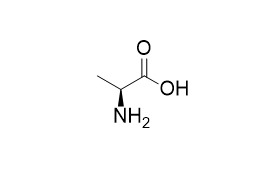L-Alanine
L-Alanine induces changes in metabolic and signal transduction gene expression in a clonal rat pancreatic beta-cell line and protects from pro-inflammatory cytokine-induced apoptosis. L-Alanine has antioxidant action, it stimulates expression of the antioxidant defense proteins HO-1 and ferritin in endothelial cells, it shows antiatherogenic potential.
Inquire / Order:
manager@chemfaces.com
Technical Inquiries:
service@chemfaces.com
Tel:
+86-27-84237783
Fax:
+86-27-84254680
Address:
1 Building, No. 83, CheCheng Rd., Wuhan Economic and Technological Development Zone, Wuhan, Hubei 430056, PRC
Providing storage is as stated on the product vial and the vial is kept tightly sealed, the product can be stored for up to
24 months(2-8C).
Wherever possible, you should prepare and use solutions on the same day. However, if you need to make up stock solutions in advance, we recommend that you store the solution as aliquots in tightly sealed vials at -20C. Generally, these will be useable for up to two weeks. Before use, and prior to opening the vial we recommend that you allow your product to equilibrate to room temperature for at least 1 hour.
Need more advice on solubility, usage and handling? Please email to: service@chemfaces.com
The packaging of the product may have turned upside down during transportation, resulting in the natural compounds adhering to the neck or cap of the vial. take the vial out of its packaging and gently shake to let the compounds fall to the bottom of the vial. for liquid products, centrifuge at 200-500 RPM to gather the liquid at the bottom of the vial. try to avoid loss or contamination during handling.
Molecules.2024, 29(5):1048.
J Pharm Anal.2016, 6(6):363-373
Natural Product Communications2020, doi: 10.1177.
Mol Cells.2018, 41(8):771-780
Phytother Res.2022, 10.1002:ptr.7592.
Enzyme Microb Technol.2022, 161:110111.
Chemistr of plant2016, 2016021195
Journal of Functional Foods2022, 98:105271.
Korean J. Crop Sci.2018, 63(2):131-139
Pharmaceuticals (Basel).2024, 18(1):19.
Related and Featured Products
Archives of Microbiology,1994.161:168–175.
Formation of L-alanine as a reduced end product in carbohydrate fermentation by the hyperthermophilic archaeon Pyrococcus furiosus.[Reference:
WebLink]
METHODS AND RESULTS:
The hyperthermophilic archaeon Pyrococcus furiosus was found to form substantial amounts of L-Alanine during batch growth on either cellobiose, maltose or pyruvate. Acetate, CO2 and H2 were produced next to alanine. The carbon- and electron balances were complete for all three substrates. Under standard growth conditions (N2/CO2 atmosphere) an alanine/acetate ratio of about 0.3 was found for either substrate. The alanine /acetate ratio was influenced, however, by the hydrogen partial pressure. In the presence of S0 or in coculture with Methanococcus jannaschii this ratio was only 0.07, whereas under a H2/CO2 atmosphere this ratio could amount up to 0.8. Alanine formation was also aflected by the NH sup+inf4concentration, i.e. below 4 mM, NH sup+inf4becomes limiting to alanine formation. Alanine formation was shown to occur via an alanine aminotransferase, which exhibited a specific activity in cell-free extract of up to 6.0 U/mg (90°C; direction of pyruvate formation). The alanine aminotransferase probably cooperates with glutamate dehydrogenase (up to 23 U/mg; 90°C) and ferredoxin: NADP+ oxidoreductase (up to 0.7 U/mg, using methyl viologen; 90°C) to recycle the electron acceptors involved in catabolism.
CONCLUSIONS:
Thus, the existence of this unusual alanine-forming branch enables P. furiosus to adjust its fermentation, depending on the redox potential of the terminal electron acceptor.
Clinical ence, 2005, 109(5):447-55.
L-Alanine induces changes in metabolic and signal transduction gene expression in a clonal rat pancreatic beta-cell line and protects from pro-inflammatory cytokine-induced apoptosis.[Reference:
WebLink]
Acute effects of nutrient stimuli on pancreatic beta-cell function are widely reported; however, the chronic effects of insulinotropic amino acids, such as L-Alanine, on pancreatic beta-cell function and integrity are unknown.
METHODS AND RESULTS:
In the present study, the effects of prolonged exposure (24 h) to the amino acid L-Alanine on insulin secretory function, gene expression and pro-inflammatory cytokine-induced apoptosis were studied using clonal BRIN-BD11 cells. Expression profiling of BRIN-BD11 cells chronically exposed to L-Alanine was performed using oligonucleotide microarray analysis. The effect of alanine, the iNOS (inducible nitric oxide synthase) inhibitor NMA (N(G)-methyl-L-arginine acetate) or the iNOS and NADPH oxidase inhibitor DPI (diphenylene iodonium) on apoptosis induced by a pro-inflammatory cytokine mix [IL-1beta (interleukin-1beta), TNF-alpha (tumour necrosis factor-alpha) and IFN-gamma (interferon-gamma)] was additionally assessed by flow cytometry. Culture for 24 h with 10 mM L-Alanine resulted in desensitization to the subsequent acute insulin stimulatory effects of L-Alanine. This was accompanied by substantial changes in gene expression of BRIN-BD11 cells. Sixty-six genes were up-regulated >1.8-fold, including many involved in cellular signalling, metabolism, gene regulation, protein synthesis, apoptosis and the cellular stress response. Subsequent functional experiments confirmed that L-Alanine provided protection of BRIN-BD11 cells from pro-inflammatory cytokine-induced apoptosis. Protection from apoptosis was mimicked by NMA or DPI suggesting L-Alanine enhances intracellular antioxidant generation.
CONCLUSIONS:
These observations indicate important long-term effects of L-Alanine in regulating gene expression, secretory function and the integrity of insulin-secreting cells. Specific amino acids may therefore play a key role in beta-cell function in vivo.



